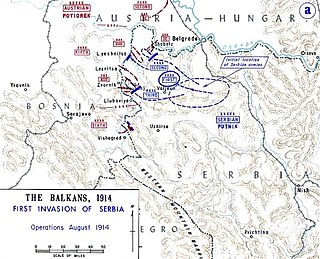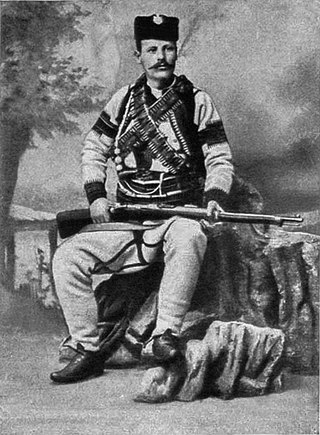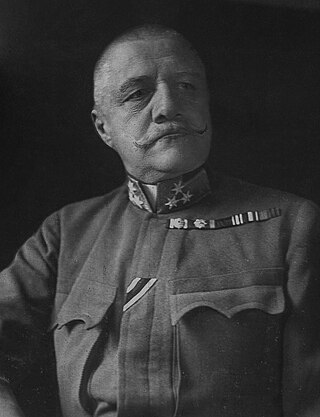
The Chetniks, formally the Chetnik Detachments of the Yugoslav Army, and also the Yugoslav Army in the Homeland and the Ravna Gora Movement, was a Yugoslav royalist and Serbian nationalist movement and guerrilla force in Axis-occupied Yugoslavia. Although it was not a homogeneous movement, it was led by Draža Mihailović. While it was anti-Axis in its long-term goals and engaged in marginal resistance activities for limited periods, it also engaged in tactical or selective collaboration with Axis forces for almost all of the war. The Chetnik movement adopted a policy of collaboration with regard to the Axis, and engaged in cooperation to one degree or another by both establishing a modus vivendi and operating as "legalised" auxiliary forces under Axis control. Over a period of time, and in different parts of the country, the movement was progressively drawn into collaboration agreements: first with the puppet Government of National Salvation in the German-occupied territory of Serbia, then with the Italians in occupied Dalmatia and Montenegro, with some of the Ustaše forces in northern Bosnia, and, after the Italian capitulation in September 1943, with the Germans directly.

The Battle of Cer was a military campaign fought between Austria-Hungary and Serbia in August 1914, starting three weeks into the Serbian Campaign of 1914, the initial military action of the First World War. It took place around Cer Mountain and several surrounding villages, as well as the town of Šabac. The Battle of Cer is known as the first Allied victory over the Central Powers in the First World War.

The Serbian campaign was a series of military expeditions launched in 1914 and 1915 by the Central Powers against the Kingdom of Serbia during the First World War.

The Kosovo offensive of 1915 was a World War I offensive launched as part of the Serbian campaign of 1915. It involved the Central Powers and the Kingdom of Serbia.

Konstantin "Kosta" Milovanović Pećanac was a Serbian and Yugoslav Chetnik commander (vojvoda) during the Balkan Wars, World War I and World War II. Pećanac fought on the Serbian side in both Balkan Wars and World War I, joining the forces of Kosta Vojinović during the Toplica uprising of 1917. Between the wars he was an important leader of Chetnik veteran associations, and was known for his strong hostility to the Yugoslav Communist Party, which made him popular in conservative circles. As president of the Chetnik Association during the 1930s, he transformed it into an aggressively partisan Serb political organisation with over half a million members. During World War II, Pećanac collaborated with both the German military administration and their puppet government in the German-occupied territory of Serbia.

During World War II, Pećanac Chetniks, also known as the Black Chetniks, were a collaborationist Chetnik irregular military force which operated in the German-occupied territory of Serbia under the leadership of vojvoda Kosta Pećanac. They were loyal to the Government of National Salvation, the German-backed Serbian puppet government.

The Austro-Hungarian Armed Forces occupied Serbia from late 1915 until the end of World War I. Austria-Hungary's declaration of war against Serbia on 28 July 1914 marked the beginning of the war. After three unsuccessful Austro-Hungarian offensives between August and December 1914, a combined Austro-Hungarian and German offensive breached the Serbian front from the north and west in October 1915, while Bulgaria attacked from the east. By January 1916, all of Serbia had been occupied by the Central Powers.

The Great Retreat, also known in Serbian historiography as the Albanian Golgotha, refers to the retreat of the Royal Serbian Army through the mountains of Albania during the 1915–16 winter of World War I.

Jovan Stojković, known as Jovan Babunski, was a Serbian Chetnik commander during the Macedonian Struggle, Balkan Wars and World War I. Following the murder of his brother and nephew by the Internal Macedonian Revolutionary Organization (IMRO), he joined a Chetnik band and took command of Chetnik units on the Vardar River, where he and his men often engaged Bulgarian and Ottoman forces.
The Toplica Uprising was a mass uprising against Bulgarian occupation force that took place in Bulgarian occupied Serbia during the First World War. The rebels were motivated by grievances against the Bulgarian authorities for ordering conscription of local Serbs in the Bulgarian army, forced labour and the denationalization policy imposed on the indigenous population. The revolt was supported by Serbian guerrilla fighters known as Chetniks.

The Surdulica massacre was the mass murder of Serbian men by Bulgarian occupational authorities in the southern Serbian town of Surdulica in 1916 and early 1917, during World War I. Members of the Serbian intelligentsia in the region, mostly functionaries, teachers, priests and former soldiers, were detained by Bulgarian forces—ostensibly so that they could be deported to the Bulgarian capital, Sofia—before being taken into the forests around Surdulica and killed. An estimated 2,000–4,000 Serbian men were executed by the Bulgarians in the town and its surroundings. Witnesses to the massacre were interviewed by American writer William A. Drayton in December 1918 and January 1919.

Kosta Vojinović, known by his nickname Kosovac (Косовац), was a Serbian soldier who fought in the Balkan Wars and World War I, most notably as a leader of the Toplica Uprising.

The attack on Kruševac was an attack of Yugoslav rebels on Axis-held Kruševac in the German-occupied territory of Serbia which lasted between 23 and 27 September 1941 during World War II.

The Bulgarian occupation of Serbia during World War I started in Autumn 1915 following the invasion of Serbia by the combined armies of Germany, Austria-Hungary and Bulgaria. After Serbia's defeat and the retreat of its forces across Albania, the country was divided into Bulgarian and Austro-Hungarian occupation zones.

The Serbian campaign of 1915 refers to a military campaign carried out by the Central Powers, primarily Germany, Austria-Hungary and Bulgaria, against the Kingdom of Serbia during World War I. The campaign took place from October to November 1915.
The Serbian Campaign of 1914 was a significant military operation during World War I. It marked the first major confrontation between the Central Powers, primarily Austro-Hungary, and the Allied Powers, led by the Kingdom of Serbia. The campaign started on 28 July 1914, when Austria-Hungary declared war on Serbia and bombarded Belgrade. On 12 August, the Austro-Hungarian forces, led by General Oskar Potiorek, launched their first offensive into Serbia.

The Military General Governorate of Serbia was a military administration established by the Austro-Hungarian Army during the Austro-Hungarian occupation of Serbia. The Governorate existed from 1 January 1916 to 1 November 1918 during World War I. Along with Bulgarian occupied Serbia, it was one of the two separate occupation zones created after the Kingdom of Serbia was invaded and partitioned by the Central Powers.
The Bombardment of Belgrade was an attack carried out by Austria-Hungary on the Serbian capital during the night of 28–29 July 1914. It is considered the first military action of World War I.

Colonel General Adolf Freiherr von Rhemen zu Barensfeld, sometimes referred to as Baron Rhemen, was a German senior officer in the Austro-Hungarian Army, known for his commanding roles during the First World War.















